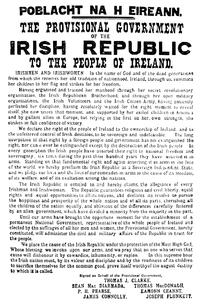Home | Military Conflict | Easter Rising
|
|
|
The Easter Rising ( ) was an insurrection staged in Ireland during Easter Week, 1916. The Rising was mounted by Irish republicans with the aims of ending British rule in Ireland and establishing the Irish Republic. It was the most significant uprising in Ireland since the rebellion of 1798. Organised by the Military Council of the Irish Republican Brotherhood, the Rising lasted from Easter Monday 24 April to 30 April 1916. Members of the Irish Volunteers, led by schoolteacher and barrister Pádraig (Patrick) Pearse, joined by the smaller Irish Citizen Army of James Connolly, along with 200 members of Cumann na mBan, seized key locations in Dublin and proclaimed the Irish Republic independent of Britain. There were some actions in other parts of Ireland but, except for the attack on the Royal Irish Constabulary barracks at Ashbourne, County Meath, they were minor. The Rising was suppressed after seven days of fighting, and its leaders were court-martialled and executed, but it succeeded in bringing physical force republicanism back to the forefront of Irish politics. In the 1918 General Election to the British Parliament, republicans (then represented by the Sinn Féin party) won 73 seats out of 105 on a policy of abstentionism and Irish independence. This came less than two years after the Rising. In January 1919, the elected members of Sinn Féin who were not still in prison at the time, including survivors of the Rising, convened the First Dáil and established the Irish Republic. The British government refused to accept the legitimacy of the newly declared nation, precipitating the Irish War of Independence. |




 RSS
RSS